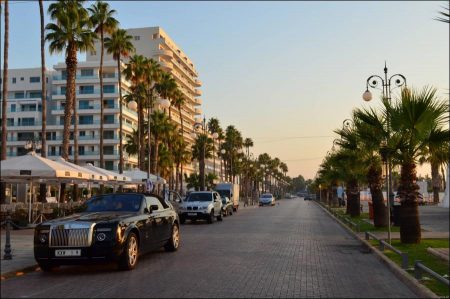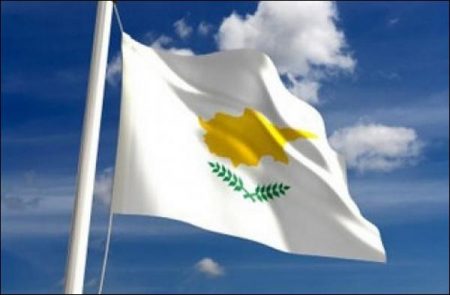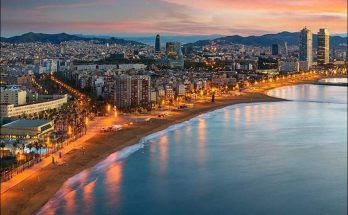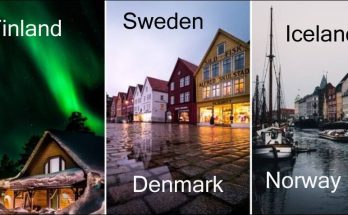Cyprus is an island state in the eastern Mediterranean Sea 60 miles west of the coast of Syria and 40 miles south of Turkey. It has an area of 3,572 square miles. The island is 140 miles from east to west and around 60 miles from north to south. It is somewhat of a box shape except a long peninsula going to the northeast.
Land
Cyprus consists of two mountain ranges and a central lowland. The Kyrenia Range lies close to the north coast and consists mainly of limestone. To the south is the Mesaoria Plain, in which the densest population is found. The southern half of the island is occupied by the rugged Troodos Mountains, composed mainly of volcanic and igneous rocks. They have a maximum elevation of 6,407 feet.
Temperatures vary with the elevation, but January averages are about 50 degrees F and those of July about 80 degrees F. Rainfall occurs mainly in winter, and is rarely more than 15 in. in the lowlands but is higher in the mountains. Surface drainage is by short, small streams that are usually dry in summer. The native vegetation is adapted to the climate and consists mainly of drought-resisting scrub and conifers including eucalyptus, pine, acacia, and cypress.
People and Economy
The island includes both Greek and Turkish peoples. The Greeks make up about 77% of the total population, and 18% of the rest are Turkish. The Turkish people live mainly on the northern part of the island. In addition to the ethnic and linguistic differences, there are religious differences. The Greeks are primarily Orthodox Christians and the Turks are mostly Muslims. Hostility has always existed between the two groups. Much of the population is rural and agricultural. Apart from Nicosia, the capital, Limassol and Famagusta, the towns are very small.
The economy is mainly agricultural, with fruits and vegetables as the chief exports. Farming is highly mechanized, and irrigation is widely used. Since prehistoric times, Cyprus has been known for its minerals. In fact, the word copper is derived from the islands name. Although the island has copper, iron pyrites, chrome, and asbestos mining is no longer as important as it once was.
The construction industry, textile manufacturing and other light industries have expanded rapidly in recent times in the Greek sector. It has also become a banking, telecommunications, and trade center for corporations in dealing with the Middle East. The Turkish region has a shortage of skilled labor, trade, and diplomatic links to the rest of the world.
History and Government
Cyprus, having a good position in the Mediterranean Sea, affected. During the 2nd millennium BC, it supplied copper to the surrounding areas. In 709 BC, Cyprus gave in to the Assyrian king Sargon II. After the Assyrians lost power, there was a time of Persian Domination. When Alexander the Great conquered the
region in the 4th century BC, Cyprus was united politically with the rest of the Greek world. At this time Cyprus consisted mainly of city-states held together under the rule of Alexander’s successors. In 58 BC, the island was annexed by the Roman Empire.
Cyprus was Christianized early on when it was visited by St. Paul. Cyprus went under the control of the Byzantine Empire after the split up of the Roman empire. The Byzantine Empire continued to rule it until 1191 BC when Richard I of England conquered it. In 1192, the island was given to Guy de Lusignan, who founded a French-speaking monarchy. The island came under Venetian control in 1489. The ruined castles and Gothic churches of Cyprus date from this period.
Cyprus was subjected to many attacks by the Turks. In 1570-71 the Turks overran the island. It was under Turkish rule until 1878. During this time, many Turks settled there. In 1879 the British occupied Cyprus to aid Turkey against Russia. In 1914 it was annexed by Great Britain. Soon afterward a movement started with the Greek Cypriots for a union with Greece. This movement became stronger after World War II. At the same time Archbishop Makarios III became the leader of the movement for an independent Cyprus.
In 1959, after a time of guerilla war, Cyprus finally became independent. Despite this, Great Britain kept its military bases. Some people still wanted union with Greece, and other wanted the division of Cyprus along its ethnic borders. Fearing that the Greek government was preparing to annex Cyprus, the Turks invaded in 1974 and forced a partition of the island in 1975.
The Greek sector, known as the Republic of Cyprus, is led by President Glafcos Clerides, who was elected in 1993. The Turkish zone, under the leadership of Rauf Denktash, declared itself the Turkish Republic of Northern Cyprus in 1983 but is recognized only by Turkey. UN-sponsored talks on reunification were held intermittently in the late 1980s and early 1990s.
Visits: 179




